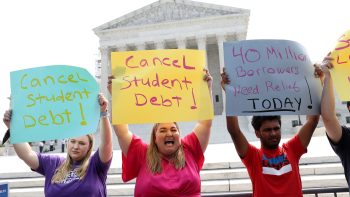
In this week’s “Make Me Smart” newsletter, we explore the rise of medical debt forgiveness, how crypto is popping up in the 2024 elections and do the numbers on Labor Day.
The News Fix
Medical debt is a real problem, even for those with health insurance. More than 100 million Americans have some kind of medical debt, according to the Kaiser Family Foundation. About 14 million people owe more than $1,000; 3 million owe more than $10,000.
Vice President Kamala Harris’ presidential campaign released an economic plan that pledges to help more states provide medical debt relief. Louisiana, Ohio, Illinois, New Jersey and North Carolina have all announced programs this summer providing billions in relief.
Erasing medical debt is popular. When polled, Americans are more likely to support canceling medical debt than student loan debt. Prices for procedures vary greatly among insurance providers, and billing is so opaque and complicated that many people don’t know how much they’ll owe until after the fact. As one expert said on “Marketplace Morning Report,” “Nobody goes looking for medical debt, it just happens upon people.”
Lawmakers like canceling medical debt because it’s a good deal. Hospitals often sell off patients’ unpaid debts for pennies on the dollar, so the government can pay off huge amounts for a tiny fraction of what individuals were charged.
But economists say it doesn’t always work. Researchers found that even after people’s medical debts were canceled, their financial well-being didn’t improve, nor did their physical or mental health, or access to credit. They also found that people who had debt forgiven were also less likely to pay other existing medical bills. While medical debt forgiveness does help, the intervention may be coming too late.
Smart in a shot

Former President Donald Trump is billing himself as the “crypto president.” The Republican presidential candidate launched his fourth collection of baseball-card-style non-fungible tokens for $99 a pop.
At one point, an estimated 12,000 NFTs were sold every day; one by the artist known as Beeple sold for $69 million in 2021. Now, nearly all NFTs created during the 2021-2022 “gold rush” are worthless.
Trump’s NFTs include a legal disclaimer stating that the digital artworks are “collectible items for individual enjoyment only, not for investment vehicles.” But the Securities and Exchange Commission classifies NFTs as securities similar to stocks and bonds, and it’s likely to soon crack down on the largely unregulated NFT market.
Trump’s views on crypto have flipped since calling digital currencies a “scam” during his presidency. He now has at least $1 million stored in a crypto wallet, according to recent campaign financial disclosures, and he’s made millions in licensing fees from his previous NFT collections. The Trump Organization also announced last week that it would be launching its own crypto platform as an alternative way to bank.
Vice President Kamala Harris has been silent on crypto, but the industry has perceived the Joe Biden administration as hostile to the technology. Biden vetoed legislation in May that would have weakened the SEC’s ability to regulate crypto assets. Other leaders in the Democratic Party are shifting their views. Senate Majority Leader Chuck Schumer spoke during a Crypto4Harris virtual event earlier this month at which he called for a “sensible crypto bill” that both promotes innovation and regulation. Crypto companies have spent $119 million so far in the 2024 election cycle on both Democrats and Republicans. We’ll have more on that for you in next week’s deep dive!
The numbers
You might want to get to the airport early this weekend — AAA is forecasting a 9% rise in Labor Day travel from last year. But this holiday weekend is about more than getaways and sales. Unions represent a small portion of the labor force, but they have an outsized impact on the economy. Let’s do the numbers.
1894
That year, President Grover Cleveland signed a law making the first Monday in September a federal holiday celebrating American workers. Numerous states had already created their own Labor Day; the first was celebrated in New York City in 1882.
25 cents
When Congress passed the Fair Labor Standards Act in 1938, it set the first federal minimum wage at 25 cents an hour. Minimum wage has been stuck at $7.25 an hour for the past 15 years, far outpaced by inflation.
One-third
About a third of the American workforce was unionized in the 1950s. Today it’s 10%. The decline of union membership over the last 50 years tracks with an increased share of income going to the top 10% of wage earners, according to the Economic Policy Institute.
10%
Union member wages typically run at least 10% higher than those of nonunion workers at similar jobs. The Economic Policy Institute found some people of color earn even more.
$12,000
Median household incomes are $12,000 higher on average in states with higher rates of union membership. More unionization in an industry or geographic area has been shown to drive higher wages for workers more broadly. Minimum wage is higher in those states too.
$2.24 million
A college-educated man in a nonunion job will earn $2.24 million over the course of his career on average. His counterpart with no college education would average $1.9 million in lifetime earnings, but a Center for American Progress analysis found being in a union job for just a fraction of that time eliminates the gap.
None of us is as smart as the rest of us
Tell us what’s making you smarter at smarter@marketplace.org. We’d love to include your recommendation in a future newsletter.
This is your brain on plastic
A new study, not yet published or peer-reviewed, reported huge increases in microplastics found in cadavers during autopsy. Editor Ed Silver is reading about how these tiny shards work their way into organs, including the brain. A different study found plastics and chemicals in them account for $249 billion in health care costs.
It’s hard to work with people betting on you
There was a lot to unpack in Bloomberg’s deep-dive issue about sports betting, but editor Tony Wagner was most interested in these first-person accounts (gift link) from NFL players about how their jobs have changed with the rise of fantasy sports and online wagering.
Zoned out
There are about 5,400 “special economic zones” worldwide, where government oversight and taxation are less intense than the surrounding area. Newsletter writer Ellen Rolfes is reading about one of these zones, the for-profit experimental city Próspera. Founded in 2017 off the coast of Honduras, the venture-capital-backed city is testing the limits of privatization.
There’s a lot happening in the world. Through it all, Marketplace is here for you.
You rely on Marketplace to break down the world’s events and tell you how it affects you in a fact-based, approachable way. We rely on your financial support to keep making that possible.
Your donation today powers the independent journalism that you rely on. For just $5/month, you can help sustain Marketplace so we can keep reporting on the things that matter to you.
















